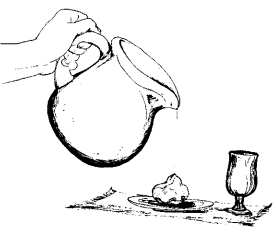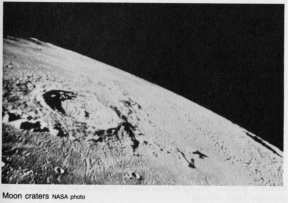
©1986 by Paul D. Ackerman http://www.creationism.org/books/ackerman/
 |
©1986 by Paul D. Ackerman http://www.creationism.org/books/ackerman/ |
|
5 - Pour Me a Rock He sends forth springs in the valleys;
|
 |
Scientists have discovered many wondrous
things about the beautiful world God has created. One of the most surprising
is that the clear and common distinction between solids and liquids becomes
blurred when long periods of time are involved. We all learned as children
that liquids flow and solids retain their shape, but if enough time is
involved, solids are found to flow just like liquids.
The Concept
Consider trying to make a sculpture out
of water. You would pour it into a mold, where it would assume the desired
shape. As soon as the mold was removed, however, the water would run down
into a puddle on the table. A sculpture made of honey would last a little
longer, but not much. These facts are well known, since people have a great
deal of experience with these common liquids.
What is not realized is that a sculpture
of glass is doing the same thing as the honey and water but much more slowly.
Given enough time, a glass figurine would also flow down into a puddle.
The flow of glass is exceedingly slow, of course, but it is fast enough
that in the span of a hundred years the bottom edge of a window pane will
measurably and noticeably thicken.
Granite is one of the hardest and slowest flowing materials on earth, but even its rate of flow has been measured by scientists. Long slender bars of granite were cut and hung horizontally with fixed attachments at both ends. Over a period of years the long bars bent in the middle as gravity caused their rock material to flow downward. Flow deformations of tombstones and other rock monuments can also be observed.
Rock Flow and the Age of the Moon
What does the fact that rock flows have to do with the age of things? An obvious feature of the moon is that in the past it has been battered by numerous collisions with large meteors. These impacts have left the lunar surface heavily scarred. Evolutionists believe that most of these craters were formed early in the moon's history, when the solar system was young and before life was established on earth. The reason for this view is in part that if the moon was bombarded, then from the evolutionist perspective the earth must have been similarly battered. The scars are not apparent on the earth's surface because, unlike the moon, the earth experiences the erosional forces of wind and water which erased the evidence of early violence.

In addition, large-scale bombardment must surely have ceased before life got started or else it would have been wiped out. For example, a current evolutionist conjecture regarding dinosaur extinction is that it resulted from the impact of an asteroid.
Recent-creationists also believe the impact craters were formed early in the moon's existence, but they believe that this was only a few thousand years ago. Thus we have two opposing views about the same phenomenon. Most scientists believe the craters to be at least three billion years old, while a few believe them to be only a few thousand. Is there a way to test and see which view is correct?
Geophysicist and astronomer Harold Slusher of the University of Texas at El Paso, along with Glenn Morton and Richard Mandock, have worked on this problem and discovered a simple and seemingly decisive solution. They have done so by considering the flow rates (viscosity) of the lunar rock material that forms the moon craters.1 If the moon were covered with water, impact craters would last only a few seconds. If it were made of honey, craters would last just a bit longer. Since the moon is covered with rock, impact craters last a much longer time, but how long depends upon the kind of rock and its viscosity or rate of flow.
The rocks brought back from the moon by our Apollo astronauts have been carefully studied and found to be virtually identical with a kind of earth rock called basalt. The discovery that the moon's surface is made up of basalt-type rock rules out the possibility that lunar craters are more than a few thousand years old! The viscosity or flow-rate value used by scientists is on the order of a hundred million times too low (the higher the value, the slower the flow rate) for the craters to have lasted three or four billion years. Even if the lunar surface were made of granite, the viscosity value of that granite would be ten million times too low to hold the crater shape for three billion years. If the lunar surface were made of the same rock material as the earth's mantle, the viscosity value would be too low by a factor of one hundred thousand.
Conclusion
Thus the physical evidence is loud and clear to the effect that the craters of the moon cannot be as old as evolutionists claim. In fact, the data indicate that the craters must be only a few thousand years old. To quote the research report of Morton, Slusher, and Mandock:
As can be seen, the lunar craters cannot last longer than a few million years for any reasonable value of the viscosity. If the viscosity of granite is the upper limit for the viscosity of basalt, then lunar craters cannot be more than a few thousand years old. . . .The evidence presented here demonstrates that the lunar surface and the craters on it are relatively young structures.2